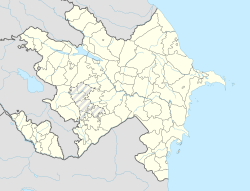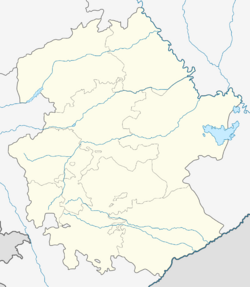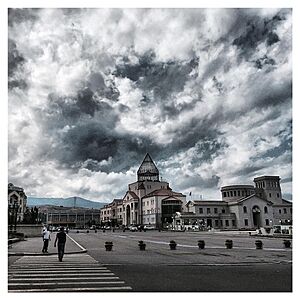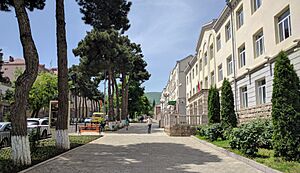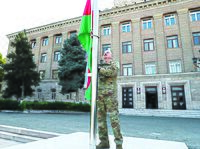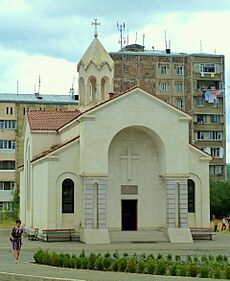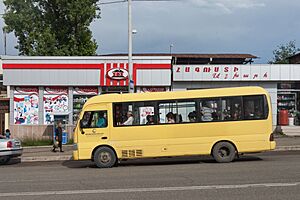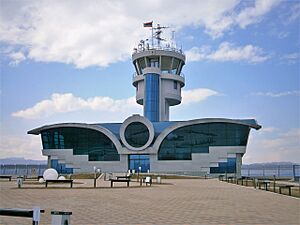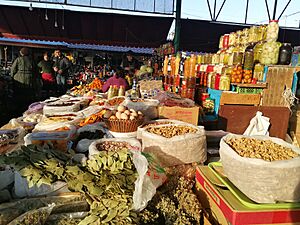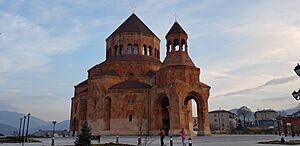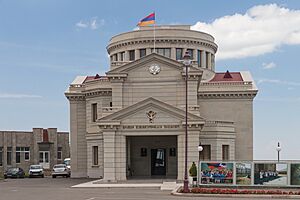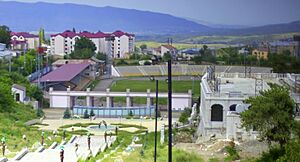Stepanakert facts for kids
Quick facts for kids
Stepanakert / Khankendi
Ստեփանակերտ
Xankəndi |
|
|---|---|
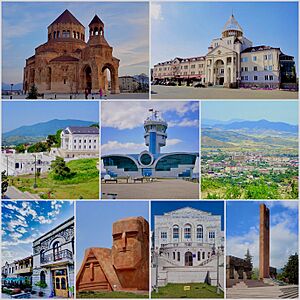
From top left:
Holy Mother of God Cathedral Renaissance Square • Downtown Stepanakert Stepanakert Airport • Stepanakert skyline Park Hotel Artsakh • We Are Our Mountains Artsakh University • Stepanakert Memorial |
|
| Country | Azerbaijan |
| Region | Karabakh |
| City status | 1940 |
| Area | |
| • Total | 29.12 km2 (11.24 sq mi) |
| Elevation | 813 m (2,667 ft) |
| Population | |
| • Total | 75,000 |
| • Density | 2,576/km2 (6,670/sq mi) |
| Time zone | UTC+4 (GMT+4) |
| Area code(s) | +994 26 |
| Sources: Stepanakert city area and population | |
Stepanakert (Armenian: Ստեփանակերտ) or Khankendi (Azerbaijani: Xankəndi) is a city in the Nagorno-Karabakh region of Azerbaijan. It is sometimes called a ghost city because most of its people left in 2023. Before that, it was the capital of the self-declared Republic of Artsakh. The city is in a valley on the eastern slopes of the Karabakh mountains. It sits on the left bank of the Qarqarçay (Karkar) river.
The area where Stepanakert is located was once an Armenian settlement called Vararakn. During the time of the Soviet Union, the city became the capital of the Nagorno-Karabakh Autonomous Oblast. It grew into an important center for business and industry. It was also a place where Armenians gathered to ask for Nagorno-Karabakh to join Armenia. The city was badly damaged during the First Nagorno-Karabakh War after the Soviet Union broke up. It then came under the control of local Armenians.
When Armenians controlled the city, it was a hub for education and culture. It was home to Artsakh University, music schools, and a palace of culture. The economy mainly focused on services. Important businesses included food processing, wine making, and silk weaving. In 2021, about 75,000 people lived in Stepanakert.
On September 29, 2023, Azerbaijani authorities took control of the city. Almost all of the Armenian population left for Armenia before the Azerbaijani forces arrived.
Contents
City Names: Stepanakert and Khankendi
Medieval Armenian records show that there was a settlement here called Vararakn. This name means "rapid spring." In 1847, Russian officials officially changed the village name to Khankendi. However, local Armenians continued to call it Vararakn until 1923.
Many Azerbaijani sources say the settlement was built in the late 1700s. It was a resting place for the leaders of the Karabakh Khanate. At first, it was known as "Khan's village" (Azerbaijani: Xanın kəndi). This was because only the khan's family and relatives lived there. By the 1800s, it was renamed Khankendi, which means "village of the khan" in Azerbaijani.
In 1923, the town was renamed Stepanakert. This name means "city of Stepan." It was named after Stepan Shahumian, an Armenian revolutionary leader. The name comes from the words Stepan and kert, which means "created" in Armenian.
History of Stepanakert
Early Beginnings and Soviet Times
Old Armenian writings say that Stepanakert was originally an Armenian village called Vararakn. From the 10th to the 16th centuries, it was part of the Armenian Principality of Khachen. Over time, it was controlled by different groups. These included the meliks of Karabakh and the Karabakh khans. In 1822, it came under the control of the Russian Empire.
During the Russian Empire, the town was part of the Shusha uezd. This was a district within the Elizavetpol Governorate. In 1847, Vararakn was a village with about 132 homes. It had 80 Armenian families and 52 Russian families. There was also an Armenian church and a cemetery. That same year, the village was renamed Khankendi.
By 1886, the settlement had 52 houses. The people living in Khankendi were mostly retired soldiers and their families. They were members of the Russian Orthodox Church. They worked in farming, crafts, and renting out homes. After 1898, the Russian government turned Khankendi into a military base. This base had barracks, hospitals, and a church. Some local people, including Armenians and Azerbaijanis, also lived there. They supplied food to the military.
In February 1920, a conflict happened in the village. After an Azerbaijani soldier's body was found, a riot occurred. Following the events in Shusha in March 1920, many Armenians moved to Stepanakert. Because of this, Armenians became the majority of the population. In the summer of 1920, the city was taken over by the Red Army.
In 1923, the Soviet government renamed Khankendi to Stepanakert. This was to honor Stepan Shahumian. Shusha was the old capital of the region. But after many Armenians left Shusha, Stepanakert became the capital of the Nagorno-Karabakh Autonomous Oblast (NKAO). At that time, Stepanakert was in bad shape. Many buildings were destroyed or damaged.
In the first years of the NKAO, many buildings were fixed or rebuilt. Roads were improved, and electricity and phones were installed. Stepanakert grew to be the most important city in the region by 1940. Its population grew from 10,459 in 1939 to 33,000 in 1978.
In 1926, city leaders approved a new plan for the city. This plan was designed by Alexander Tamanian. More plans for growth were approved later, but they kept Tamanian's original ideas. Several schools and two clinics were built. An Armenian drama theater was started in 1932. In 1960, the main square of Stepanakert was built. This square became a place for many protests. People gathered there to ask for the NKAO to join the Armenian SSR.
By 1968, some ethnic tensions occurred in Stepanakert. An Azerbaijani school director was accused of a crime. Armenians felt the judge's decision was too light. They gathered outside the court and burned the car the criminal and judge were in.
Stepanakert was the main economic center of Nagorno-Karabakh. By the mid-1980s, there were 19 factories in the city. These included electrical and asphalt plants. By the end of the Soviet era, Stepanakert had many schools. It had an agricultural school, a teaching institute, and medical and music schools. There was also a local history museum and a drama theater.
First Nagorno-Karabakh War and Armenian Control
In 1985, Soviet leader Mikhail Gorbachev started new reforms. These reforms gave more power to local areas. Armenians in both Armenia and Nagorno-Karabakh saw this as a chance to unite. On February 20, 1988, thousands of Armenians protested in Stepanakert's Lenin Square. They demanded that the region join Armenia. On the same day, the Nagorno-Karabakh parliament voted to join the Armenian SSR. Azerbaijani authorities strongly opposed this.
Relations between Armenians and Azerbaijanis in Stepanakert worsened. In September 1988, conflicts broke out in the city. There were physical attacks and property was burned. This caused almost all Azerbaijanis to leave the city. The Soviet Army came into the city and set a curfew. In 1990, the army sent special forces to Stepanakert. This was to prevent Azerbaijani forces from taking over.
After Azerbaijan became independent from the Soviet Union in 1991, Stepanakert was renamed Khankendi by the Azerbaijani government. Fighting began over control of Nagorno-Karabakh. After three years of war, Armenians gained control of the region. They also controlled a path connecting it to Armenia. Before the war, Stepanakert was the largest city in the NKAO. It had a population of 70,000. By early 1992, this number dropped to 50,000.
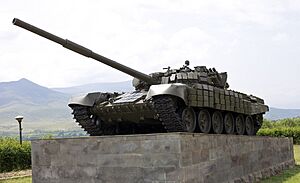
During the war, the city was heavily bombed by Azerbaijan. This was especially true in early 1992. Azerbaijani forces used rockets from Shusha to attack Stepanakert. A journalist noted in April 1992 that "scarcely a single building [had] escaped damage." The bombing stopped on May 9, 1992, when Shusha was captured. However, the city continued to be bombed from the air until the war ended. As a result, most of the city was severely damaged. By 2016, the city had not been fully repaired from the war.
The city was bombed intensely again during the Second Nagorno-Karabakh War in 2020. Residential areas were hit by the Azerbaijani Army. Residents were told to use the city's bomb shelters. As Azerbaijani forces moved closer to Shusha, the Lachin corridor was closed.
A ceasefire agreement was signed on November 10. This happened when Azerbaijani forces were about 15 kilometers from the capital. As part of the agreement, Russian peacekeepers were sent to the region. After the war, Stepanakert's population grew to 75,000. This was because 10,000 to 15,000 people who lost their homes elsewhere moved there.
Control by Azerbaijan
On September 19–20, 2023, Azerbaijan launched a new military action in the region. This ended in a ceasefire. It led to a mass departure of ethnic Armenians a few days later. By September 29, 2023, police from Artsakh left their weapons in Stepanakert. They completely left the region. Azerbaijani police vehicles began patrolling the area. The Azerbaijani flag was placed on the city's We Are Our Mountains monument.
From October 1, Azerbaijani officials started working from the former Artsakh police headquarters. Azerbaijan took over medical services in the city. The area was also covered by Azerbaijani mobile networks. An Al Jazeera news team reported from the city. They showed empty streets, describing it as "A ghost town with no soul left."
President Ilham Aliyev visited the city on October 15. He officially raised the flag of Azerbaijan at the building that was once the Artsakh Presidential Palace.
In the months that followed, Azerbaijani authorities removed monuments. These included the Giant Cross and the Eagle Monument. Statues of important Armenians were also removed. Among them were Stepan Shahumyan (who Stepanakert is named after), Charles Aznavour, and Alexander Myasnikyan.
In early March 2024, Azerbaijani authorities tore down the National Assembly of Artsakh Building. They also demolished the Artsakh Freedom Fighters Union Building.
Geography and Climate
Stepanakert is located on the Karabakh Plateau. It is about 813 meters (2,667 feet) above sea level.
The city has a humid subtropical climate. This means it has hot, humid summers and mild winters. In January, the average temperature is about 1°C (34°F). In July, it averages around 23°C (73°F). The coldest temperature ever recorded was -15°C (5°F) in January 1974. The hottest was 37°C (99°F) in July 1978.
| Climate data for Stepanakert (1961–1990 normals, extremes 1959–1991) | |||||||||||||
|---|---|---|---|---|---|---|---|---|---|---|---|---|---|
| Month | Jan | Feb | Mar | Apr | May | Jun | Jul | Aug | Sep | Oct | Nov | Dec | Year |
| Record high °C (°F) | 16.1 (61.0) |
19.0 (66.2) |
22.8 (73.0) |
30.3 (86.5) |
30.0 (86.0) |
37.0 (98.6) |
37.0 (98.6) |
36.0 (96.8) |
31.0 (87.8) |
25.0 (77.0) |
21.2 (70.2) |
21.0 (69.8) |
37.0 (98.6) |
| Mean daily maximum °C (°F) | 4.7 (40.5) |
5.2 (41.4) |
9.0 (48.2) |
16.1 (61.0) |
19.5 (67.1) |
24.5 (76.1) |
28.1 (82.6) |
27.1 (80.8) |
23.2 (73.8) |
16.4 (61.5) |
11.4 (52.5) |
7.3 (45.1) |
16.0 (60.9) |
| Daily mean °C (°F) | 1.1 (34.0) |
1.4 (34.5) |
5.1 (41.2) |
11.6 (52.9) |
15.3 (59.5) |
19.8 (67.6) |
23.3 (73.9) |
22.3 (72.1) |
18.7 (65.7) |
12.6 (54.7) |
7.7 (45.9) |
3.7 (38.7) |
11.9 (53.4) |
| Mean daily minimum °C (°F) | −2.6 (27.3) |
−2.5 (27.5) |
1.1 (34.0) |
7.0 (44.6) |
11.0 (51.8) |
15.1 (59.2) |
18.4 (65.1) |
17.4 (63.3) |
14.2 (57.6) |
8.7 (47.7) |
4.0 (39.2) |
0.1 (32.2) |
7.7 (45.8) |
| Record low °C (°F) | −15.0 (5.0) |
−11.0 (12.2) |
−12.7 (9.1) |
−1.0 (30.2) |
4.0 (39.2) |
6.6 (43.9) |
11.3 (52.3) |
10.9 (51.6) |
6.0 (42.8) |
−2.0 (28.4) |
−6.0 (21.2) |
−8.6 (16.5) |
−15.0 (5.0) |
| Average precipitation mm (inches) | 19 (0.7) |
25 (1.0) |
42 (1.7) |
49 (1.9) |
102 (4.0) |
79 (3.1) |
41 (1.6) |
27 (1.1) |
34 (1.3) |
39 (1.5) |
35 (1.4) |
13 (0.5) |
505 (19.9) |
| Average precipitation days | 6 | 6 | 10 | 10 | 14 | 10 | 4 | 4 | 6 | 6 | 5 | 4 | 85 |
| Source: NOAA | |||||||||||||
People and Population
| Year | Armenians | Azerbaijanis | Others | Total | |||
|---|---|---|---|---|---|---|---|
| Number | % | Number | % | Number | % | ||
| 1897 | 628 | 42.0 | 442 | 29.6 | 425 | 28.4 | 1,495 |
| 1926 | 2,724 | 85.4 | 343 | 10.8 | 122 | 3.8 | 3,189 |
| 1939 | 9,079 | 86.8 | 672 | 6.4 | 708 | 6.8 | 10,459 |
| 1959 | 17,640 | 89.5 | 1,143 | 5.8 | 920 | 4.7 | 19,703 |
| 1970 | 26,684 | 88.1 | 2,762 | 9.1 | 847 | 2.8 | 30,293 |
| 1979 | 33,898 | 87.0 | 4,303 | 11.0 | 747 | 2.0 | 38,948 |
| September 1988: First Nagorno-Karabakh War: Many Azerbaijanis left the city | |||||||
| 2005 | 49,848 | 99.7 | 2 | 0.0 | 136 | 0.3 | 49,986 |
| 2010 | 52,900 | 52,900 | |||||
| 2015 | 55,309 | 55,309 | |||||
| September–November 2020:Second Nagorno-Karabakh War | |||||||
| 2021 | 75,000 | 75,000 | |||||
| September 2023: Azerbaijani offensive in Nagorno-Karabakh | |||||||
In 1886, there were 71 houses and 279 people in Khankendi. Most of them were Russians. There were also 2 Armenians and 1 Tatar (now known as Azerbaijani). In 1897, the village had 1,495 people. This included 628 Armenian Apostolics, 442 Muslims, and 394 Orthodox Christians.
In 1908, Khankendy had 362 residents, mostly Russians. By 1912, it had 1,076 residents, also mainly Russians. In 1915, there were 1,550 residents, mostly Tatars. In 1921, Khankendi had 1,208 residents, mostly Armenians. By 1973, Stepanakert's population had grown to 32,000 people.
Religion
The old church of Vararakn from the late 1800s was destroyed in the 1930s. This was done to build the Stepanakert Drama Theatre. During the rest of the Soviet era, there were no traditional churches in Stepanakert. However, most people in the city were members of the Armenian Apostolic Church.
The church of Surp Hakob (Saint James) opened in 2007. It was the only open church in the city until 2019. A person named Nerses Yepremian from Los Angeles paid for the church. It was dedicated on May 9, 2007. This was to celebrate the 15th anniversary of Armenian forces taking Shusha.
The building of the Holy Mother of God Cathedral started on July 19, 2006. The project was expected to cost about $2 million. The architect was Gagik Yeranosyan. However, construction was slow because there wasn't enough money. The church was expected to open in September 2016. Construction finished, and the church opened in 2019.
There was also a small group of Armenian Evangelicals, with about 500 members. The only Armenian evangelical church in Artsakh was in Stepanakert. This community supported many schools, hospitals, and other places. They received help from the Armenian Diaspora.
Transportation
Bus Travel
Stepanakert had many regular minibus lines. Old Soviet-era buses were replaced with new, modern ones. There were also regular trips to other areas of Nagorno-Karabakh from the city.
Air Travel
Stepanakert was served by the nearby Stepanakert Airport. This airport is north of the city, close to Khojaly. In 2009, work began to rebuild and repair the airport. It was supposed to start commercial flights on May 9, 2011. But officials postponed the opening date several times. In May 2012, the director of Artsakh's Civil Aviation Administration said the airport would open in summer 2012. However, the airport is still closed due to political reasons.
Train Travel
Stepanakert used to be connected by a railway line to the Yevlakh station. This station is on the Baku-Tbilisi railway. However, train trips were stopped because of the Nagorno-Karabakh conflict.
Economy and Work
When Artsakh controlled the city, Stepanakert was a regional center for education and culture. It had Artsakh University, music schools, and a palace of culture. The economy was mostly based on service industries. Important businesses included food processing, wine making, and silk weaving. In 2021, the city had a population of 75,000 people.
Stepanakert was the main economic hub of Artsakh. Before the First Nagorno-Karabakh War, its economy focused on food processing, silk weaving, and winemaking. People also made furniture and shoes. The economy was badly hurt by the 1988 earthquake in Armenia and the First Nagorno-Karabakh War. In the years after, the economy grew again. This was mainly due to money invested by the Armenian diaspora. However, after the 2020 Nagorno-Karabakh War, the economy was damaged again, especially tourism.
The most developed parts of Stepanakert's economy were tourism and services. Several hotels were opened by Armenians living abroad. Artsakhbank was the biggest bank in Artsakh. Karabakh Telecom was the main provider of mobile phones and other communication services.
Stepanakert also had many large factories. These included the Stepanakert Brandy Factory, Artsakh Berry food products, and Artsakh Footwear Factory.
Construction was also a leading industry in the city. Artsakh Hek was the main construction company. Base Metals was a leader in mining and making building materials.
Culture and Arts
The Vahram Papazyan Drama Theater in Stepanakert was founded in 1932. In 1967, a large monument called We Are Our Mountains was built north of Stepanakert. It is seen as a symbol of the Armenian heritage of the historic Artsakh region. After Armenia became independent, many cultural and youth centers reopened. The city's cultural palace is named after Charles Aznavour.
Stepanakert is home to several important cultural places. The Mesrop Mashtots Republican Library opened in 1924. The Artsakh History Museum opened in 1939. The Hovhannes Tumanyan Children's Library opened in 1947. The Stepanakert National Gallery opened in 1982. The Memorial Museum of the Martyred Liberators opened in 2002. A new cultural center for Armenian heritage in Artsakh is also being built.
The Artsakh State Museum in Stepanakert has a large collection of old artifacts and Christian writings.
Education and Learning
Stepanakert was the main center for higher education in Artsakh. Five universities and colleges operated in the city:
- Artsakh State University: Founded in 1969, it became a full university in 1992. It offers courses in seven departments and has 4,500 students.
- Stepanakert campus of the Armenian National Agrarian University.
- Grigor Narekatsi University (private).
- Mesrop Mashtots University (private).
- Gyurjyan Institute for Applied Arts (private).
Many new schools in Stepanakert opened from the late 1990s to 2010. These were built with help from the Armenian diaspora. Existing schools were also renovated with donations from the diaspora.
The Stepanakert branch of Tumo Center for Creative Technologies opened in September 2015. This was a result of teamwork between Tumo and the Armenian General Benevolent Union. It also had support from Karabakh Telecom.
Sports and Games
Football is a popular sport in Nagorno-Karabakh. The city has a renovated football stadium. Since the mid-1990s, football teams from Karabakh have played in some Armenian competitions. Lernayin Artsakh is the football club that represents Stepanakert. The Artsakh national football league started in 2009.
The Artsakh national football team was formed in 2012. It is not part of FIFA. They played their first official match against the Abkhazia national football team in Sukhumi on September 17, 2012. The game ended in a 1–1 tie. The next month, on October 21, 2012, Artsakh played the return match at the Stepanakert Republican Stadium. They won 3–0.
People in Stepanakert also enjoy other sports. These include basketball and volleyball.
Artsakh athletes also take part in the Pan-Armenian Games. These games are organized in Armenia. Since Artsakh is not a recognized country, its athletes compete in international sports under the flag of Armenia.
Sister Cities and Friendship
Stepanakert has sister city relationships with other places:
- Montebello, United States: On September 25, 2005, Montebello, California, and Stepanakert became sister cities. This partnership aims to help Stepanakert's economy. It also builds cultural and educational ties.
- Mairiporã, Brazil: Since June 18, 2018, Mairiporã and Stepanakert have been sister cities.
Stepanakert has also signed friendship agreements with other cities:
- On May 22, 1998, Stepanakert and Villeurbanne in France signed a Friendship Declaration.
- On September 28, 2012, Stepanakert and Yerevan, Armenia, became friends. They signed a partnership agreement.
- On September 15, 2014, San Sebastián, Spain, and Stepanakert signed a cooperation agreement.
- On May 17, 2015, Stepanakert and Valence in France signed a Friendship Declaration.
- On February 3, 2016, Stepanakert signed a Friendship Declaration with Franco da Rocha, Brazil.
- On July 23, 2019, Stepanakert signed a Friendship Declaration with the City of Ryde, Australia.
Notable People from Stepanakert
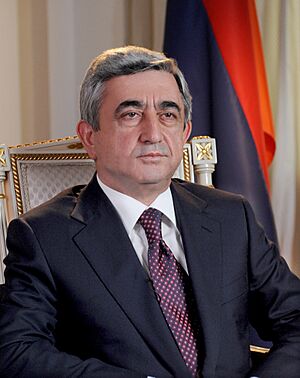
- Armen Abaghian – An Armenian academic.
- André – An Armenian singer.
- Don Askarian – An Armenian filmmaker.
- Vladimir Arzumanyan – An Armenian singer who won the Junior Eurovision Song Contest 2010.
- Samvel Babayan – An Armenian military general.
- Zori Balayan – An Armenian writer.
- Karen Karapetyan – The 14th Prime Minister of Armenia.
- Robert Kocharyan – The second President of Armenia.
- Fakhraddin Manafov – An Azerbaijani actor.
- Bakhshi Galandarli – An Azerbaijani theater figure, actor, and director.
- Serzh Sargsyan – The third President of Armenia.
- Roza Sarkisian – A theater director in Ukraine.
- Nikolay Yenikolopyan – A Soviet Armenian chemist and academician.
- Gor Manvelyan – A professional footballer.
|
See also
 In Spanish: Stepanakert para niños
In Spanish: Stepanakert para niños


